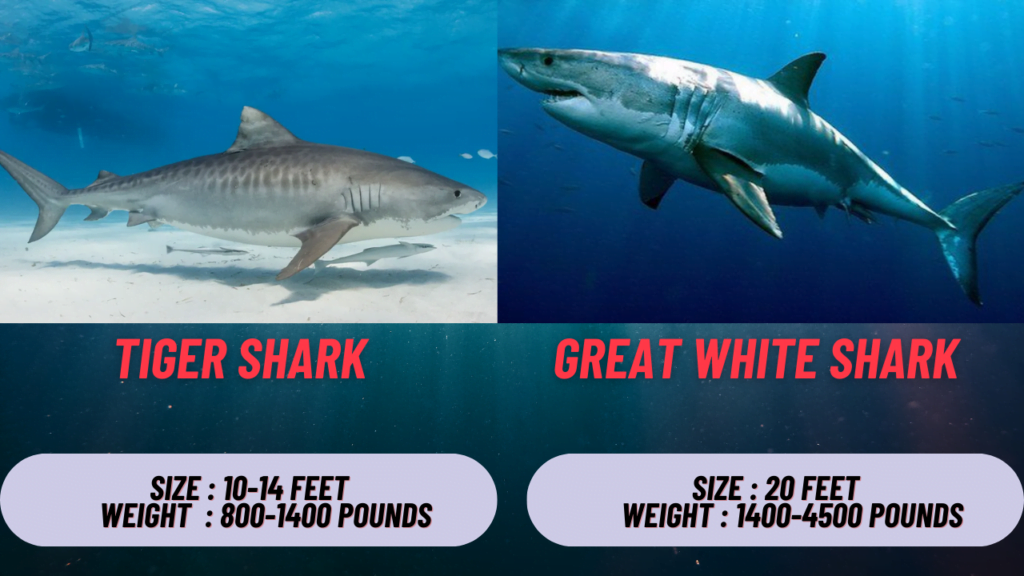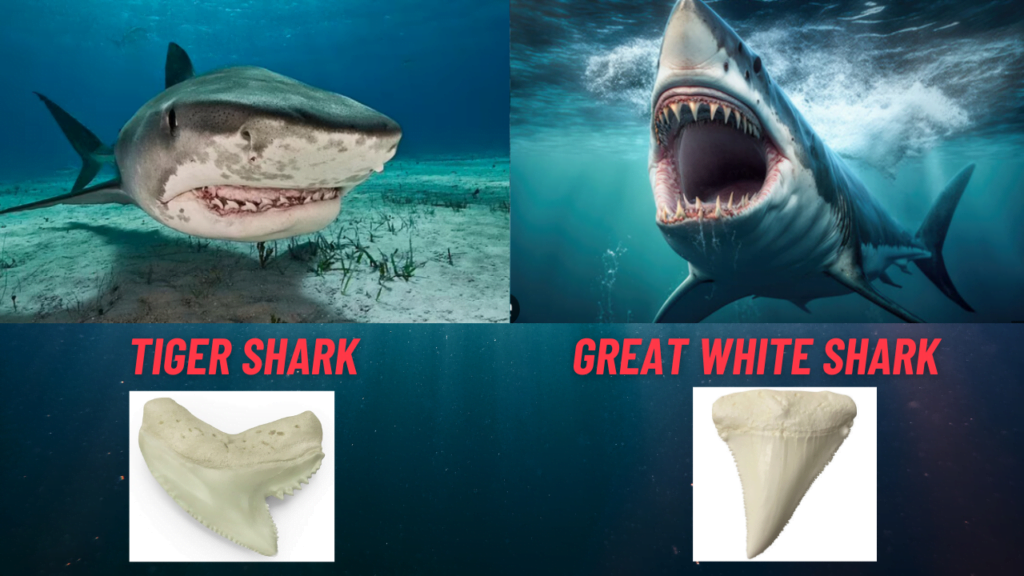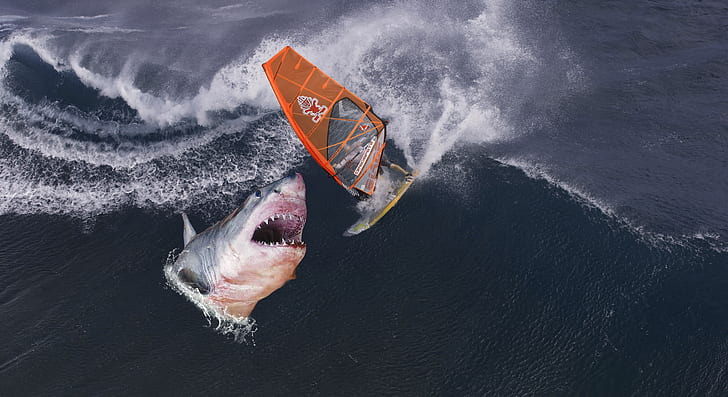The oceans contain some of the most powerful predators on Earth. But who is the apex hunter of the sea? Two names stand out: the Tiger Shark (Galeocerdo Cuvier) and the Great White Shark (Carcharodon Carcharias). For centuries they both have captivated our imaginations with awe and fear. But which shark reigns supreme as the greatest predator of seas when compared head to head? Let us compare some key attributes and find out which shark is truly the ruler of the ocean. Welcome to the epic war between two of the most fearsome predators of the deep blue sea – Tiger Shark Vs Great White Shark!
But before we go deep down into the battle ground, we must know few things about sharks.
What are Sharks
- Sharks are a group of predatory fish that have existed for over 400 million years.
- There are over 500 known species of sharks living in oceans around the world.
- Sharks have torpedo-shaped bodies and powerful tails that enable them to swim very fast – some species can swim over 60 mph!
- Sharks come in all sizes. The largest is the whale shark which gets as large as 60 feet. The smallest is the Dwarf Lantern shark which can fit in your hand.
- Sharks have cartilage while most fish have bone. Cartilage is flexible and less dense, while bone is hard and rigid.
- cartilage allows sharks to be more buoyant and agile swimmers. It also saves weight and allow fast maneuvering.
- They continually shed their teeth throughout their lives. Some species go through over 30,000 teeth in a lifetime!
- Sharks have a special sense on their snout called “ampullae of Lorenzini” which can detect electric fields and temperature changes in the water.
- This keen sense allow them to track prey, predators, and mates at varying distances.
- Approx. 50% of shark species are threatened or near threatened with extinction on the IUCN Red List of Threatened Species.
- The Florida Museum of Natural History’s International Shark Attack File investigated 120 alleged shark-human interactions worldwide in 2023.
- ISAF confirmed 69 unprovoked shark bites and 22 provoked bites on humans. The United States recorded the most unprovoked shark bites in 2023, with 36 confirmed cases.
- New Smyrna Beach of Florida is known as the “Shark Bite Capital of the World”. The Beach has 343 recorded shark bites from 1882-2023.
Tiger Shark Vs Great White | The Deadliest Battle of 2024
Size
Winner – Great White Shark

- An average adult Tiger shark reaches lengths of 10-14 feet (3-4.3 m) and weighs 850-1400 pounds (385-635 kg).
- The largest tiger sharks can grow up to 18 feet (5.5 m) and weigh almost 2000 pounds (900 kg).
- They have a robust, cylindrical body with a blunt snout and tiger-like stripes on their sides.
- The Great White shark reaches lengths of up to 20 feet (6 m), but is considerably more slender and light-framed.
- Great whites weigh around 1500-4500 pounds (700-2000 kg) on average.
- They have a streamlined body, powerful tail, and a conical snout filled with rows of saw-like teeth.
#Tiger Shark Vs Great White | In pure size and bulk, The Great White shark has the edge over the tiger shark.
Lifespan
Winner – Great White Shark
- According to NOAA -The age of shark species can be estimated by counting growth bands on fin spines or vertebrates. It is much like rings on a tree.
- The life span of Tiger sharks believed to be is around 27 years for males and 21 years for females. Some studies suggest that they may live up to 50 years or more.
- Tiger sharks reach sexual maturity at around 7-10 years of age for males and 9-14 years of age for females.
- Tiger sharks are Ovoviviparous, which means that they produce eggs. These eggs hatch inside the mother’s body and the pups are born live. They give birth to between 10 and 80 pups per litter depending on their size and age.
- Great white sharks have a longer estimated life span. Males live up to about 50-70 years and females live up to about 40 years.
- They reach sexual maturity at around 12-18 years of age.
- Great white sharks are also ovoviviparous, but they have a lower fertility than tiger sharks. They typically give birth to 2 to 10 pups per litter.
- Both species have a gestation period of about 12-18 months
#Tiger Shark Vs Great White | Long living-Great White Shark takes the prize here.
Speed and Agility
Winner – Tie
Great whites are faster sprint swimmers than tiger sharks. They are capable of reaching speeds up to 35 mph (56 km/h) in short bursts. Their average speed is around 20-25 mph. Great white shark is the second fastest shark in the world after Shortfin Mako Shark. The secret behind this greater speed is their torpedo-like body shape and powerful tail.
The tiger shark has a maximum speed of about 22 mph (35 km/h) in short bursts. Tiger sharks are known for their exceptional agility, particularly in tight spaces and around reefs. Tiger sharks have excellent maneuverability thanks to their sleek body & broad pectoral fins. They can roll, tilt and change direction rapidly. Great white sharks are also agile, but they are not as maneuverable as tiger sharks in reef environments.
#Tiger Shark Vs Great White | Great white shark takes the lead in Speed while Tiger shark is better in maneuvering.
Teeth
Winner – Tiger Shark

The Tiger Shark‘s teeth are unique and perfectly designed for its diverse diet. They have much broader, thicker teeth that resemble blunt spikes or saw blades. These teeth are built to hunt. The lower jaw of the Tiger Shark contains multiple rows of teeth. Biologists believe that the tiger shark’s teeth are better suited for grasping and tearing apart a wide range of prey. They can easily tear apart turtle shells and other hard-shelled prey.
Great White Shark teeth are triangular, razor-sharp, and less serrated along the edges. They can grow up to 3 inches long. Their teeth are arranged in rows embedded in the shark’s gums. When one tooth falls out, another rotates forward to take its place. They can have as many as 300 in their mouth at a time. A Great White Shark can go through as many as 50,000 teeth in its lifetime.
#Tiger Shark Vs Great White | In teeth structure, The Tiger shark has the edge over the Great White.
Bite Force
Winner – Great White Shark
The Great White shark possesses one of the most powerful bites among all living creatures. Many studies suggest that the bite force of a fully grown Great White Shark can exceed 4,000 pounds per square inch (psi). Their powerful jaws and bite force can crush seals and sea lions in a single bite.
The Tiger Shark‘s bite force is not as deeply studied as the Great White’s, but it is still impressive. It is estimated that the Tiger Shark’s bite force can range anywhere from 1,000 to 1,800 psi.
#Tiger Shark Vs Great White | When it comes to bite force, the Great White Shark reigns supreme.
Hunting and Diet
Winner – Tie
Tiger Shark is known as the “garbage cans of the sea.” They have a diverse diet and will eat almost anything they come across. Their consumption includes fish, seabirds, smaller sharks, sea turtles, dolphins, crabs, and even inanimate objects like license plates, gasoline cans and even tires. Tiger sharks hunt using stealth, camouflage, and short bursts of speed. They are nomadic wanderers whose broad diet allows them to thrive in any habitats of ocean.
In contrast, Great White sharks are specialist hunters. They are finely adapted for taking large marine mammals like seals, sea lions, and even whales. Unlike tiger sharks, they rely on close-quarter ambush hunting. They often engages in a “hit and run” tactic. They ambush its prey from below and inflicting a devastating wound. Once the prey weakens, the white shark will return to consume it. Their main hunting grounds are near seal colonies.
#Tiger Shark Vs Great White | Both sharks are highly skilled hunters with varied diets.
Habitat and Range
Winner – Great White Shark
Tiger sharks prefer warm, coastal waters and avoid temperate and arctic regions. They live in deep waters off coral reefs and also roam in shallow waters. They stay in deeper waters in day and move closer to the coast to hunt at night. Their range spans from Japan to New Zealand in the western Pacific Ocean and from the southwestern United States to South America in the eastern Pacific Ocean. They also found on the coasts of India and eastern Africa.
Great white sharks are found in almost all major oceans from temperate to subtropical waters. They inhabit coastal and offshore waters, as well as deep-sea habitats. They are more of a migratory behavior, So their range covers thousands of miles. They are known to frequent areas with high seal and sea lion populations. They are sighted off the coasts of the United States, Mexico Australia, and South Africa. Gansbaai of South Africa is known as the “Great White Shark Capital of the World.” It is a popular area for shark cage diving
#Tiger Shark Vs Great White | Tiger sharks stick closer to the coast in warm waters, while Great white sharks roam vast oceanic regions.
Attacks on Human
Winner – Great White Shark

The Great White, Tiger, and Bull sharks are the “Big Three” in the shark attack world. The reason is :They are big, commonly found in human activity areas, and they are the apex predators of the oceans.
According to INTERNATIONAL SHARK ATTACK FILE: Statistically, Great white sharks are responsible for more unprovoked attacks on humans than any other species. They are responsible for 351 unprovoked attacks on humans worldwide, of which 59 were fatal. On the contrary Great white sharks do not actively hunt people as prey. Their most attacks are cases of mistaken identity, out of curiosity and confusion. They usually does not consume the victim. The film “Jaws” directed by Steven Spielberg has contributed a very negative perception of Great white sharks as ruthless man-eaters.
Tiger sharks are on second position for attacks on humans, after Great white. They are responsible for 142 unprovoked attacks on humans worldwide, of which 39 were fatal. Tiger Sharks are opportunistic feeders. They become aggressive if they feel threatened or if they mistake a human for prey. They are not known as man-eaters.
#Tiger Shark Vs Great White | Great white shark take a lead with more recorded attacks on humans.
Conservation Status
Winner – Tie
The International Union for Conservation of Nature (IUCN) has classified the Tiger Shark as “Near Threatened.” It means they are close to qualifying for a threatened category in the near future if their population declines continue. The species is at a high risk of extinction in its natural habitats. Tiger sharks face several threats, including overfishing, habitat loss, and shark finning. They are highly valued in the fishing industry for their fins, skin, teeth and other body parts in the shark fin trade.
The IUCN classifies the Great White Shark as “Vulnerable”. This status reflects the significant risk of extinction in the wild. Their large size and reputation as apex predators make them vulnerable. They are also vulnerable to the impacts of climate change.
#Tiger Shark Vs Great White | Both tiger sharks and great white sharks face conservation challenges
Dangers to Sharks
Approximately 50% of shark species are threatened or near threatened with extinction on the IUCN Red List of Threatened Species.
According to the Shark Stewards Organization– Shark finning kills an estimated 100 million or more sharks globally per year. Shark finning is a fishing practice where sharks are caught and their fins are sliced off, then the body of the shark is discarded, alive or dead. Shark fins are particularly sought after a traditional Chinese medicine and shark fin soup which is considered a delicacy in Asia.
FAQs: Tiger Shark Vs Great White Shark
Q1: Who can defeat great white shark?
A: Orcas. They are large, intelligent, and powerful. Great white shark will leave the hunting prey if an orca is present around.
Q2: Do great whites eat tiger sharks?
A: No, Tiger shark is not a natural prey of Great white. They coexist in the same marine ecosystems without constant conflict.
Q3: Who is queen of ocean?
A: Nukumi! A mature female great white shark of the Atlantic is called the queen of the ocean.
Q4: Who is bigger? Tiger shark or great white.
A: The great white shark is larger than the tiger shark.
Q5: Which is the most aggressive shark?
A: The Great White, Tiger, and Bull sharks are the “Big Three” in the shark attack world.
Q6: Does sharks attract to period blood of a menstruating woman?
A: Monthly period is a complex biological fluid actually made up of three main fluids: blood, vaginal secretions, and cells shedding from the walls of your uterus. It is unlikely sharks can identify it as a blood or be attracted to it.
Final Verdict
And there you have it! A head-to-head comparison of these two apex predators of ocean. Now it’s your turn to decide: Based on the attributes we covered, which ocean hunter comes out on top in your book – The deadly tiger shark or the killer Great white? Do you agree with the ‘winners’ declared for each category or might you judge differently? Share your thoughts and opinions in the comments below!

